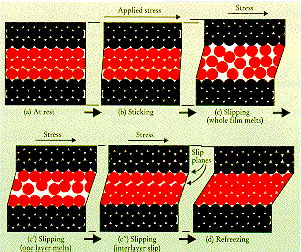| |
Lubrication
Lubrication
is associated with the presence of an intermediate layer
between two surfaces in relative motion. The material of the layer may be
a gas, liquid, or solid and have a thickness of a few atomic layers or fractions
of a millimeter. The diagram illustrates the effect on an atomic scale
layer of the shear between the two "rigid" surfaces.
Initially,
the lubricant layer has a solid structure and bonds to both surfaces. As
a stress is applied, the layer will distort in shear until the applied shear
stress is large enough to overcome the surface bonding. Beyond this shear
condition the lubricant layer may behave as a liquid (c), or remain attached
to both surfaces but 'melt' at its center (c'), or retain its solid structure
and show interlayer slip between its planes (c"). When the external shear
force is removed, the lubricant reorganizes its structure to that of the
initial state but with a permanent displacement between its two surfaces. |
|
|
|
|
|
|
|
|
|
|
|

